PONTIAC GRAND-AM 1993 Repair Manual
Manufacturer: PONTIAC, Model Year: 1993, Model line: GRAND-AM, Model: PONTIAC GRAND-AM 1993Pages: 306, PDF Size: 15.39 MB
Page 61 of 306
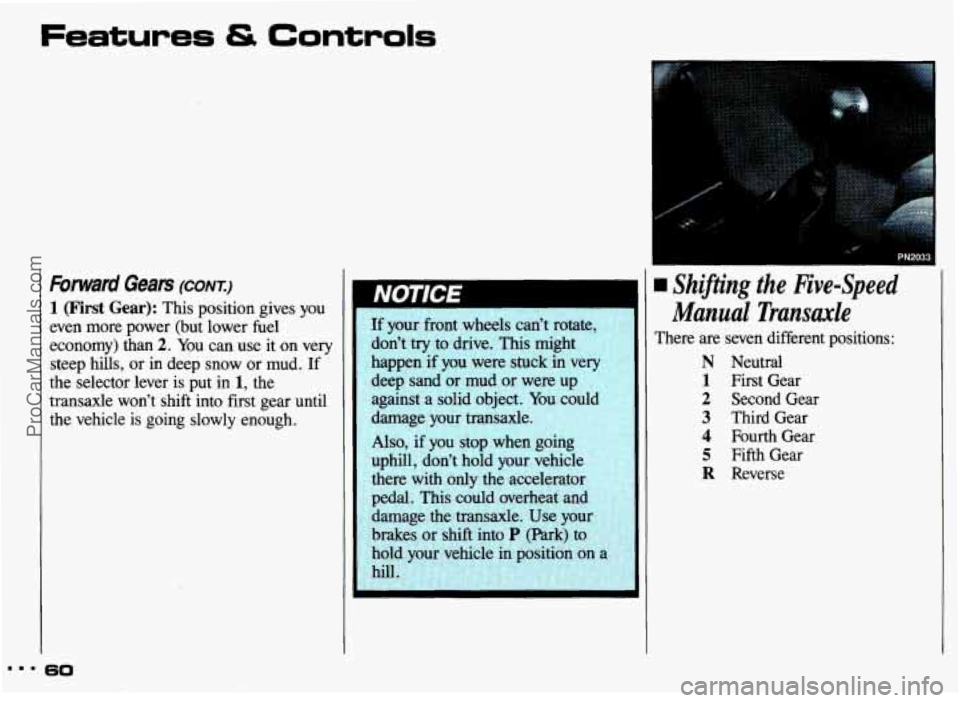
Forward Gears (CONT.)
1 (First Gear): This position gives you
even more power (but lower fuel
economy) than
2. You can use it on very
steep hills,
or in deep snow or mud. If
the selector lever is put in 1, the
transaxle won’t shift into
first gear until
the vehicle is going slowly enough. If your front wheels can’t rotate,
don’t
try to drive. This might
happen if you were stuck in very
deep sand or mud or were up
against a solid object. You could
damage your transaxle.
Also, if you stop when going
uphill, don’t hold your vehicle
there with only the accelerator
pedal. This could overheat and
damage the transaxle. Use your
,.brakes
or shift into P (Park) to
:hold your vehicle
in position on a ’ hill.
PN2033.
..
Shiftins the Five-Speed
Manual Transaxle
There are seven different positions:
N Neutral
1 First Gear
2 Second Gear
3 Third Gear
4 Fourth Gear
5 Fifth Gear
R Reverse
888 60
ProCarManuals.com
Page 62 of 306

1 3 5
2 4 R
This is your shift pattern. Here’s how to
operate your transaxle:
1 (First Gear): Press the clutch pedal
and shift into
1. Then, slowly let up on
the clutch pedal as you press the accelerator pedal.
You can shift into
1 when you’re going
less than
20 mph (32 km/h). If you’ve
come to a complete stop and it’s hard to
shift into
1, put the shift lever in
N (Neutral) and let up on the clutch.
Press the clutch pedal back down. Then
shift into
1.
2 (Second Gear): Press the clutch pedal
as you let up on the accelerator pedal
and shift into
2. Then, slowly let up on
the clutch pedal as you press the
accelerator pedal.
3,4 and 5 (Third, Fourth and Fifth
Gears): Shift into 3, 4 and 5 the same
way you do for
2. Slowly let up on the
clutch pedal as you press the accelerator
pedal.
To Stop: Let up on the accelerator pedal
and press the brake pedal. Just before
the vehicle stops, press the clutch pedal and the brake pedal, and shift into
N (Neutral).
N (Neutral): Use this position when
you
start or idle your engine.
R (Reverse): To back up, press the
clutch pedal and shift into
R. Let up on
the clutch pedal slowly while pressing
the accelerator pedal.
Shift to
R (Reverse) only after your
vehicle is stopped. Shifting to
R (Reverse) while your vehicle is
moving could damage your
transaxle.
Also, use
R (Reverse), along with the
parking brake, for parking your vehicle.
ProCarManuals.com
Page 63 of 306

Features & Controls
Shift Light (MANUAL TRANSAXLE)
If you have a manual transaxle, you have
a SHIFT light. This light will show you
when to shift to the next higher gear for
best fuel economy.
When this light comes
on, you can shift
to the next higher gear if weather, road
and traffic conditions let you. For the
best fuel economy, accelerate slowly and
shift when the light comes on.
While you accelerate, it is normal for
the light to go on and off if you quickly
change the position of the accelerator.
Ignore the
SHIFT light when you
downshift.
Shift Speeds (MANUAL TRANSAXLE)
This chart shows when to shift to the
next higher gear for best fuel economy.
Acceleration Shift Speeds for 2.3L
OHC and 2.3L High Output Quad 4
Engines (Codes 3 and A):
Ist to 2nd 15 mph (24 km/h)
2nd to 3rd 25 mph (40 km/h)
3rd to 4th 40 mph
(64 km/h)
4th to 5th 45 mph (72 km/h)
If your speed drops below 20 mph
(32 km/h), or if the engine is not
running smoothly, you should downshift
to the next lower gear. You may have to
downshift two or more gears to keep the
engine running smoothly or for good
performance.
If you skip more than one gear
when you downshift, or
if you race
the engine when
you downshift,
you can damage the clutch
or
transaxle.
ProCarManuals.com
Page 64 of 306

1.
Parking Brake
To Set the Parking Brake:
Hold the regular brake pedal down with
your right foot. Push down the parking
brake pedal with your left foot.
If the
ignition is
on, the brake system warning
light will come on.
To Release the Parking Brake:
Hold the regular brake pedal down. Pull
the
BRAKE RELEASE lever.
%riving with the parking
can cause your
rear
overheat. You may have to replace
them,
and you could also damage
other parts of your vehicle.
If You are on a Hill:
See the Index under Parking on Hills.
That section shows how to turn your
front wheels.
If You are Towing a Trailer and are
Parking on a Hill:
See the Index under Towing a Trailer.
That section shows what to do first to
keep the trailer from moving.
ProCarManuals.com
Page 65 of 306
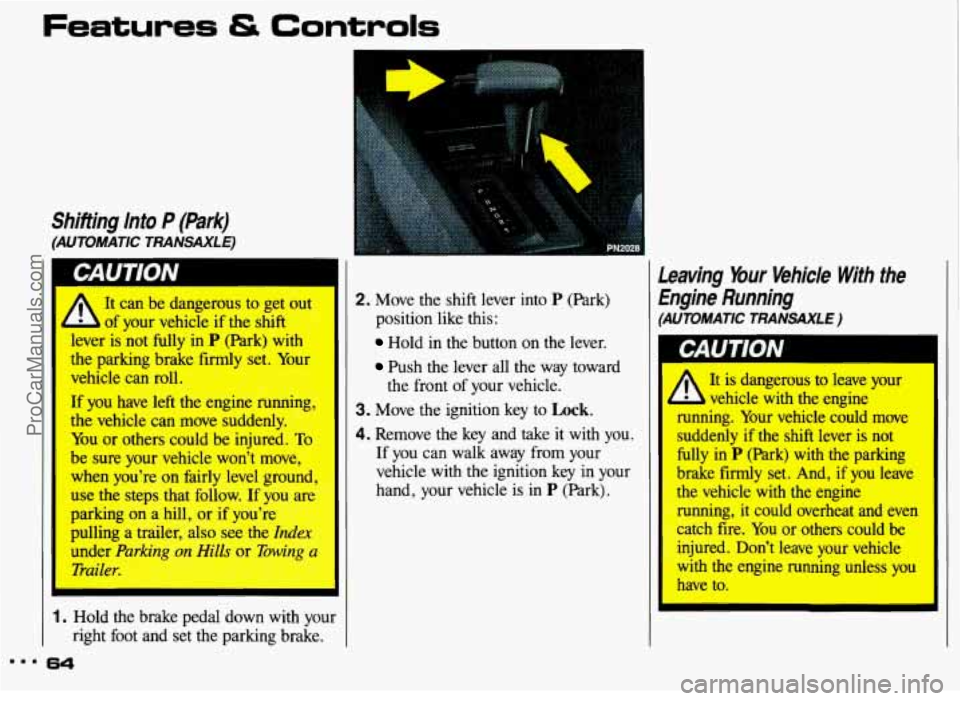
Shifting Into P (Park)
(AUTOMATIC TRANSAXLE)
A
It can be dangerous to get out
of your vehicle if the shift
I
lever is not fully in P (Park) with
the parking brake firmly set. Your
vehicle can roll.
If you have left the engine running
the vehicle can move suddenly.
You or others could be injured.
Tc
be sure your vehicle won’t move,
when you’re on fairly level ground,
use the steps that follow. If you arc
parking on a hill, or if you’re
I
pulling a trailer, also see the Inden
under ParkinP 01 lills or %wing .
“rail
I
1. Hold the brake pedal down with your
right foot and set the parking brake.
8.. 64
2. Move the shift lever into P (Park)
position like this:
Hold in the button on the lever.
Push the lever all the way toward
the front of your vehicle.
3. Move the ignition key to Lock.
4. Remove the key and take it with you.
If you can walk away from your
vehicle
with the ignition key in your
hand, your vehicle is in
P (Park).
Leaving Your Vehicle With the
Engine Running
(AUTOMATIC TRANSAXLE)
It is dangerous to leave your
running. Your vehicle could move
suddenly
if the shift lever is not
fully
in P (Park) with the parking
brake firmly set. And,
if you leave
the vehicle
with the engine
running,
it could overheat and even
catch fire. You or others could be
injured. Don’t leave your vehicle
with the engine
rumins unless you,
have to.
h- *2-- ;,a,&#:+h .u ’ -. :.
L vehicle with the engine
i- ’-
ProCarManuals.com
Page 66 of 306

If you have to leave your vehicle with
the engine running, be sure your vehicle
is in
P (Park) and your parking brake is
firmly set before you leave it. After
you’ve moved the
shift lever into the
P (Park) position, hold the regular brake
pedal down. Then, see if you can move
the shift lever away from
P (Park)
without first pushing the button.
If you can, it means that the shift lever
wasn’t fully locked into
P (Park).
Shifting Out of P (Park)
(AUTOMATIC TRANSAXLE)
Your Pontiac has a brake-transaxle shift
interlock. You have to
apply your
regular brake
before you can shift from
P (Park) when the ignition is in the Run
position. See the Index under Automatic
Transaxle.
If you cannot shift out of P (Park), ease
pressure on the shift lever-push the
shift lever all the way into
P (hrk)- as
you maintain brake application. Then
move the shift lever into the gear you
wish. (Press the shift lever button before
moving the shift lever.) If you ever hold the
brake pedal down
but still can’t shift out
of P (Park), try
this:
1. Turn the key to Off.
2. Apply and hold the brake until the
3. Shift to N (Neutral).
4. Start the vehicle and then shift to the
drive gear you want.
5. Have the vehicle fixed as soon as you
can. end of Step
4.
65
ProCarManuals.com
Page 67 of 306
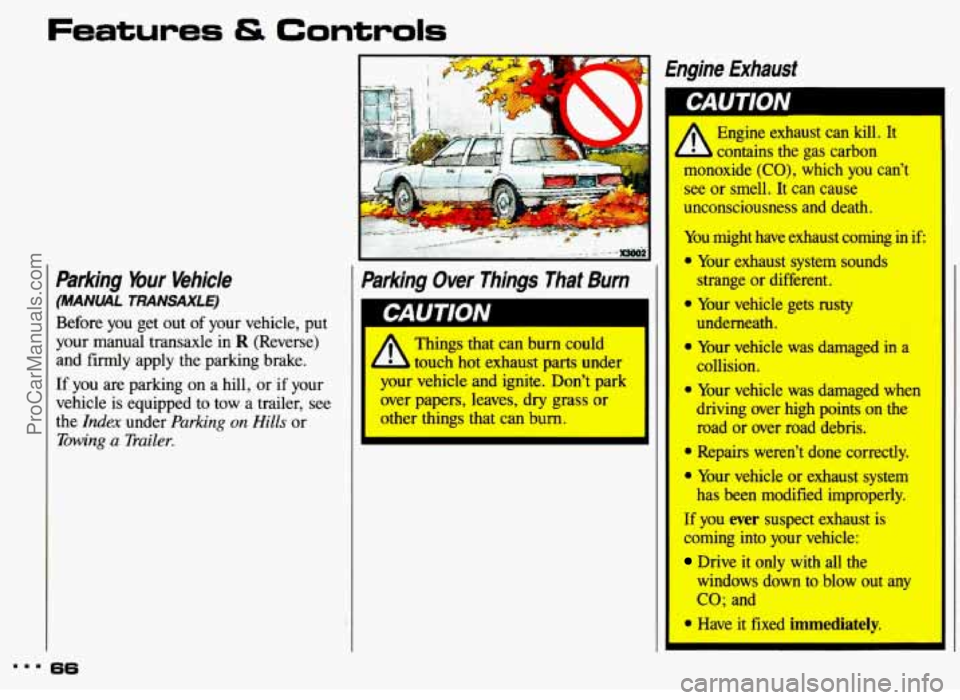
Features & Controls
Parking Your Vehicle
(MANUL TRANSAXLE)
Before you get out of your vehicle, put
your manual transaxle in
R (Reverse)
and firmly apply the parking brake.
If you are parking on a hill, or if your
vehicle
is equipped to tow a trailer, see
the Index under Parking on Hills or
i%w*ng a Trailer.
36
1 Engine Exhaust
I
Parking Over Things That Burn
Things that can burn could
touch hot exhaust parts under
your vehicle
and ignite. Don’t park
over papers, leaves, dry grass or
other things that can burn.
Engine exhaust can kill. It
contains the gas carbon
monoxide
(CO), which you can’t
see or smelt It can cause
unconsciousness and death.
You might have exhaust coming
in if:
* Your exhaust system sounds
strange or different.
* Your vehicle gets rusty
undemath.
* Your vehicle was damaged in a
collision.
* Your vehicle was damaged when
driving over high points on the
road or over road debris.
* Repairs weren’t done correctly.
* Your vehicle or exhaust systkm
has been modified improperly.
If you eys suspect exhaust is
~rrmi@ into your vehicle:
Drive it only wifh all the
windows down to blow out any
co; and
* Have it -fixed immediately.
ProCarManuals.com
Page 68 of 306
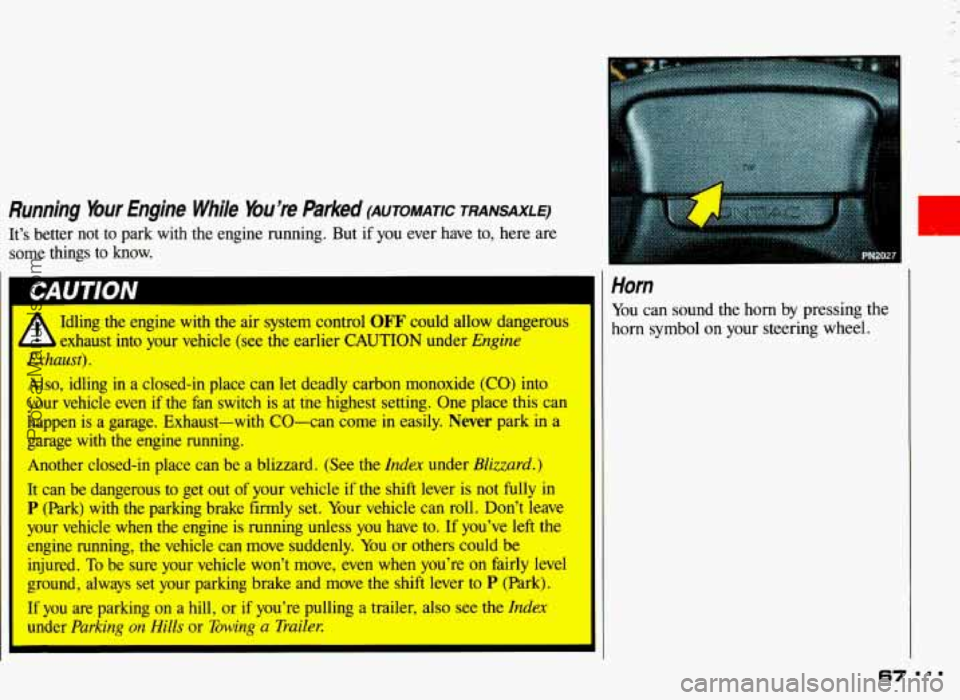
Running Your Engine While You’re Parked (AuToMmc TRANSAXLE)
It’s better not to park with the engine running. But if you ever have to, here are
some things to know.
A Idling the engine with the air system control OFF could allow dangerous
1 exhaust into your vehicle (see the earlier CAUTION under Engine
Exhaust).
Also, idling in a closed-in place can let deadly carbon monoxide (CO) into
your vehicle even if the
hn switch is at tne highest setting. One place this can
happen is a garage. Exhaust-with CO-can come
in easily. Never park in a
garage with the engine running.
Another closed-in place can be
a blizzard. (See the Index under Blizzard.)
It can be dangerous to get out of your vehicle if the shift lever is not fully in
P (Park) with the parking brake firmly set. Your vehicle can roll. Don’t leave
your vehicle when the engine is running unless you have
to. If you’ve left the
engine ruhing, the vehicle can move suddenly. You or others could be
injured.
To be sure your vehicle won’t move, even when you’re on fairly level\
ground, always set your parking brake and move the shift lever to J’ (Park). .
If you are parking on a hill, or if you’re pulling a trailer, also see the Index
under Parking on Hills or Towing a Trailer.
I’
Horn
You can sound the horn by pressing the
horn symbol on your steering wheel.
67
ProCarManuals.com
Page 69 of 306

...
Features & Controls
Ti/t Steering Wheel (opTIoN)
A tilt steering wheel allows you to
adjust the steering wheel before you
drive.
You can also raise it to the highest level
to give your legs more room when
you
exit and enter the vehicle.
To tilt the wheel, hold the steering
wheel and pull the lever.
Move the steering wheel to a comfort-
able level, then release the lever to lock
the wheel in place.
38
Windows
On a vehicle with manual windows, use
the window crank to open and close
each window.
I N21
Power Windows (opTIoN)
With power windows, switches on the
center console control each of the
windows when the ignition is
on. In
addition, each passenger door has a
control switch for its own window.
The driver’s window switch has an Auto
Down feature. The driver’s window can
be opened to any position by pushing
the rear of the switch to the first detent.
When the switch is fully depressed, the
window will go down all the way.
To stop the window while it
is lowering,
press the switch, then release.
To raise the window, press and hold the
switch forward.
ProCarManuals.com
Page 70 of 306
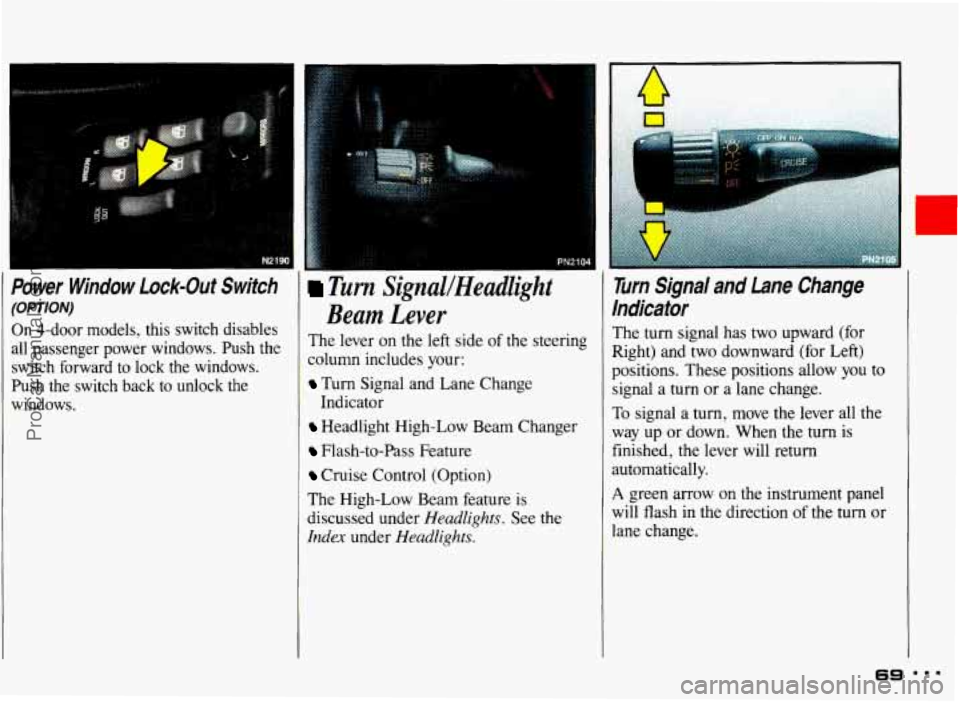
I
Power Window Lock-Out Switch
(OPT/Off)
On 4-door models, this switch disables
all passenger power windows. Push the
switch forward to lock the windows.
Push the switch back to unlock the
windows.
Turn SignallHeadlight
Beam
Lever
The lever on the left side of the steering
column includes your:
Turn Signal and Lane Change
Headlight High-Low Beam Changer
Flash-to-Pass Feature
Cruise Control (Option)
The High-Low Beam feature is
discussed under
Headlights. See the
Index under Headlights.
Indicator
Turn Signa/ and Lane Change
lndicator
The turn signal has two upward (for
Right) and two downward (for Left)
positions. These positions allow you to
signal a turn or a lane change.
To signal a turn, move the lever all the
way up or down. When the turn is
finished, the lever will return
automatically.
A green arrow on the instrument panel
will flash in the direction of the turn
or
lane change.
ProCarManuals.com